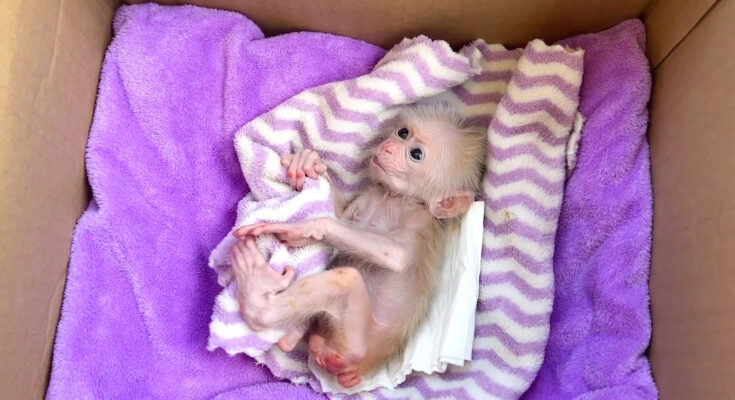Discover Essential Tips for Raising a Newborn Baby Monkey! 🐒✨ From bonding basics to health care, learn how to give your baby monkey the best start. Dive into the world of primate parenting and uncover expert advice on nutrition, safe handling, and creating a nurturing environment. Whether you’re a first-time caregiver or an animal enthusiast, these tips will help ensure your little one’s growth and happiness. Start your journey with confidence!
There’s something universally heartwarming about watching a baby take its first steps — and when that baby is a tiny, wide-eyed monkey, it’s pure magic. In this post, we’re going to share a special moment that has melted hearts all over the internet: a baby monkey learning to walk for the very first time.
🐒 Born Into a Loving Troop
Baby monkeys are born into close-knit groups called troops, where family bonds are strong and caring for young ones is a shared responsibility. From birth, the infant clings to its mother’s belly, feeling the rhythm of her heartbeat and the warmth of her fur.
In those early weeks, the baby is completely dependent on its mother — not just for protection, but also for food and comfort.
🍼 How Baby Monkeys Are Fed in the Family
Feeding begins immediately after birth. The mother nurses her baby several times a day with rich, nutritious milk that helps build strength and immunity. This milk is the baby’s only source of nutrition for the first few months of life.
But the care doesn’t stop with the mother. In many monkey species, other female members of the troop — often called “aunties” — will help carry, groom, and even hold the baby. This behavior, known as alloparenting, creates a supportive environment where the baby is surrounded by constant love and attention.
As the baby grows, it begins to show interest in solid food by watching its mother and other adults. It may reach out to grab small pieces of fruit or leaves. This is how young monkeys learn to eat by imitation, slowly transitioning from milk to the natural foods found in their environment.
👣 The First Steps: A Moment of Courage
After weeks of clinging to its mother and crawling cautiously, the baby monkey begins to experiment with standing. One day, with a bit of courage and encouragement from its mother nearby, it lets go — and takes its first wobbly steps.
The troop may pause, quietly watching. The baby stumbles, regains balance, and keeps going. It’s a powerful moment of independence, even if it only lasts a few seconds. These first steps are a symbol of growth, bravery, and the strength of nurturing care.
❤️ A Glimpse Into the Emotional World of Monkeys
This small step is more than just movement — it’s a sign of how monkeys, like humans, grow through love, learning, and social support. From feeding to walking, baby monkeys develop by observing and being guided by their families.
It also reminds us that monkeys are not just intelligent — they are emotional, social, and deeply connected creatures. Their relationships mirror our own in many ways.
🎥 Shared Around the World
Moments like these are often captured in sanctuaries or natural reserves and shared with millions online. Viewers around the world react with joy and awe, often commenting:
- “So pure and sweet.”
- “This baby monkey is just like a toddler!”
- “Nature is beautiful.”
🌍 Why It Matters
Baby monkeys face many threats — from habitat loss to illegal pet trade. Many are rescued by wildlife organizations and cared for in sanctuaries where they can safely grow, learn, and one day return to the wild.
These emotional milestones remind us how important it is to protect these animals and their families.
🐾 Final Thoughts
Watching a baby monkey take its first steps — after being fed, nurtured, and encouraged by a loving family — is a powerful reminder of the beauty of nature and the importance of family bonds in the animal world.
Tiny steps, guided by love, can lead to a lifetime of adventure.
You Won’t Believe What Happens When a Baby Monkey Shares Food with a Kitchen Monkey!

When the baby monkey tried to share, the kitchen monkey had other plans… 🍌🙈 Get ready for a mix of mischief, munchies, and monkey madness!
Ever wondered what it’s like to feed a baby monkey at home? 🍼🐒 Spoiler: it’s adorable, messy, and way more work than you think!
Playful & fun:
“Feeding a baby monkey sounds fun… until they steal the spoon, your heart, and maybe your sandwich! 🍌💛”
Curious & engaging:
“Can you really feed a baby monkey like a pet? Let’s find out—one tiny bite at a time! 🐒👶🍽️”
Cute with a caution twist:
“They may look cute during feeding time, but raising a baby monkey isn’t all bananas and cuddles! 🍌😅”
about:blank
Cute & heartwarming:
“Laughter, cuddles, and monkey mischief — could this tiny friend be the secret to a happier home? 🐵🏡❤️”
Playful & curious:
“Think your kids are a handful? Wait until a baby monkey joins the family fun! 😂🐒”
Realistic with a sweet twist:
“They bring joy, laughter, and a little chaos — but can a baby monkey really make your family happier? Let’s find out!”
Feeding a baby monkey is a delicate and important task that mimics the way its mother would care for it in the wild. Here’s a detailed guide about feeding a baby monkey, covering nutrition, care, and common mistakes to avoid:
🍼 1. Age Matters – Know What Stage the Monkey Is In
- Newborn to 2 months: Needs a milk-only diet, usually every 2–4 hours.
- 2 to 6 months: Begin introducing soft solids like mashed fruits while continuing milk.
- 6 months and older: Gradually transition to more variety in fruits, veggies, and monkey-safe protein sources.
🥛 2. Milk Formula – Not Just Any Milk
- Never use cow’s milk – it’s too harsh for their stomach.
- Use a special primate milk replacer (e.g., Esbilac Puppy Milk or Zoologic 33/40), which closely mimics monkey mother’s milk.
- Feed with a nurser bottle or syringe with care to avoid choking.
- Warm the milk to body temperature (about 37°C / 98.6°F).
🍌 3. Solid Food – Start Soft and Natural
Once the monkey is ready for solids (2–3 months), you can begin with:
- Mashed banana, papaya, or mango
- Soft boiled sweet potato
- Smashed boiled egg yolk
- Steamed vegetables like carrots or peas
⚠️ Avoid anything processed, salty, sugary, or spicy.
💧 4. Hydration is Crucial
- Always provide clean, fresh water.
- Use a small shallow bowl or a pet water bottle.
- Avoid sugary drinks or fruit juices.
🚫 5. Foods to NEVER Feed a Baby Monkey
- Chocolate
- Avocado (can be toxic in large amounts)
- Onions or garlic
- Caffeine (coffee, tea, soda)
- Alcohol (yes, some people try—never do this)
🕒 6. Feeding Schedule Example (3–6 Months)
| Time | Meal |
|---|---|
| 7:00 AM | Warm milk + mashed banana |
| 10:00 AM | Small piece of soft fruit or egg yolk |
| 1:00 PM | Milk + soft vegetable mash |
| 4:00 PM | Fruit snack |
| 7:00 PM | Milk before sleep |
🧼 7. Hygiene & Clean Feeding
- Sterilize bottles and feeding tools.
- Wash your hands before and after handling food.
- Clean up spilled food quickly to avoid attracting insects.
❤️ 8. Bonding Time
Feeding is not just nutrition — it’s a bonding ritual.
- Talk softly while feeding.
- Gently hold the monkey close for comfort.
- Use this time to build trust and emotional connection.
If you’re planning to keep or care for a baby monkey, remember:
They require as much attention as a human toddler — sometimes more.
Always check with a vet or exotic animal specialist for personalized advice.


